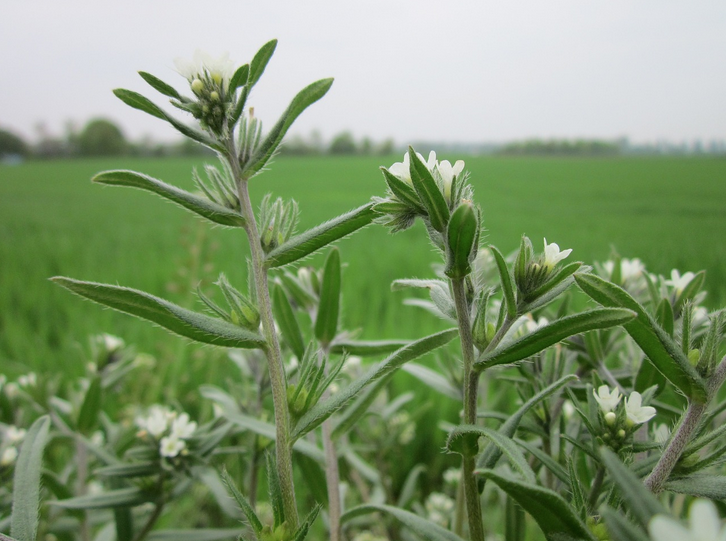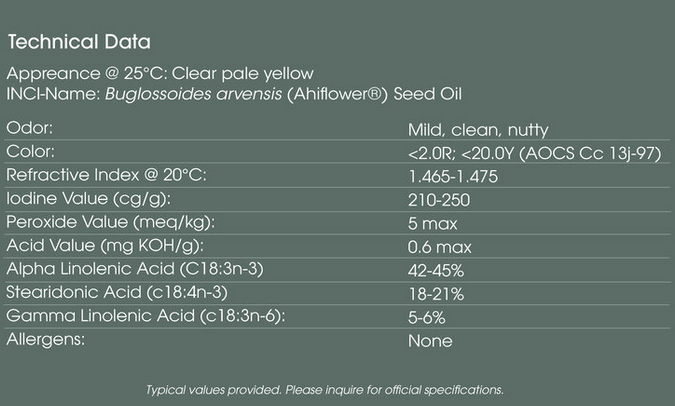
Ahiflower oil, derived from the seeds of a plant called Buglossoides arvensis, provides a new vegan-friendly, sustainably sourced option for boosting essential fatty acid levels and mitigating pro-inflammatory physiological states.
The research shows that Ahiflower—so named because it represents a plant-based alternative to omega-rich oils from fatty fish like the Ahi tuna–provides the richest, most complete and balanced omega fatty acid profile available from a non-genetically modified botanical source.
Ahiflower oil is in the same category as flax, chia, hemp, or evening primrose seed oils, but its overall omega-3-6-9 fatty acid content is higher. It has the highest omega-3 stearidonic acid (SDA) level of any plant-based omega alternative, as well as a high gamma-linolenic acid (GLA) content. That’s on top of a balanced core of alpha-linolenic (ALA) and linoleic acid (LA) acids in an optimal ~4:1 omega-3 to 6 ratio.
B. arvensis, also called Lithospermum arvense, and known colloquially as Field Gromwell, is in the borage family, and is native to most of Europe, the United Kingdom, and parts of Asia. It grows easily and in some parts of the world it is considered to be a weed. The plant produces small, white, five-petaled flowers, and its seeds are extremely oil-rich. This oil has a clean taste and aroma which aids greatly with patient compliance.
After Ahiflower supplementation, LPS-stimulated macrophages had a 45% higher interleukin-10 (IL-10) expression. IL-10 is an anti-inflammatory cytokine that is part of the body’s natural ‘quelling’ response to pro-inflammatory events.
Ahiflower oil has only been available in the US and Europe as a food and dietary supplement ingredient since 2015. Its introduction and rising popularity are due largely to the efforts of Natures Crops International, a Canadian company commited to regenerative agriculture. The company sources the oil from growers in the UK who follow the Crop Assured 365 sustainability and stewardship principles.
Alternative to Marine Oils
I became interested in Ahiflower oil after a number of my colleagues and patients began talking about it as a plant-based alternative to fish oil.
As an integrative family physician for more than 15 years, I was well aware of the science supporting omega-3 supplementation for cardiovascular and cognitive wellness, and increased longevity. Many of us as medical professionals routinely recommend daily fish oil supplements for help in cholesterol management and glycemic balance, along with immune, joint, skin, and brain health.
But marine-based products—whether from fish or krill—are not a good option for vegetarians, vegans, or those who simply don’t want to consume fish or seafood. A new plant-based source of omegas was certainly welcome news.
The clinical research supporting Ahiflower oil is compelling. Controlled human clinical trials show unmatched metabolic conversion to longer chain omega-3s.
The first human clinical trial, published in 2016 by researchers at the Université de Moncton, Canada, established Ahiflower oil’s safety at high daily intakes of over 9 grams per day. The study compared Ahiflower versus flax seed oil, and showed that the former has superior long-chain omega-3 conversion efficiency.
In a cohort of 40 healthy subjects randomized to equivalent daily doses of flax or Ahiflower oil for 28 days, those taking Ahiflower had circulating omega-3 EPA levels up to 4 times higher than those in the flaxseed oil cohort (p<0.01). Tissue levels of EPA were also higher in the Ahiflower group, averaging 3 times higher in erythrocytes, mononuclear cells, and neutrophils.
Further, the Ahiflower oil cohort showed significantly higher circulating dihomo gamma linolenic acid (DGLA). In contrast, the DGLA levels decreased significantly in the flaxseed cohort. Since both EPA and DGLA are notable for their anti-inflammatory and/or pro-resolving effects, this particular finding has clinical relevance.
The second human clinical trial, also by Natalie Lefort and her colleagues at Université de Moncton, confirmed the ability of Ahiflower oil to raise circulating EPA and DGLA levels in healthy subjects, but this time from a dose-ranging perspective. In subjects taking Ahiflower oil, EPA and DGLA levels showed a linear response at intakes as low as 2.7 grams per day, compared with a (non-active) sunflower oil placebo. This brings Ahiflower’s anti-inflammatory support benefits into the range of typical dietary supplement intake levels — roughly 2-3 grams/day, or about half a teaspoon.

Key physical and chemical features of Ahiflower oil
Cytokine Modulation
Given the types of patients I see, I was interested to learn that the researchers went a step further and examined whether Ahiflower oil could influence cytokine expression in plasma and mononuclear cells, and in lipopolysaccharide (LPS)-stimulated macrophages. Their goal was to determine whether Ahiflower oil could support the body’s natural anti-inflammatory cytokine response.
After the period of Ahiflower supplementation, LPS-stimulated macrophages had a 45% higher interleukin-10 (IL-10) expression compared with baseline levels (p<0.05). IL-10 is generally recognized as an anti-inflammatory cytokine produced by M2 immunosuppressive monocyte/macrophages.
The unique cell-signaling and metabolic effects associated with Ahiflower oil may be tied to its very high combined SDA and GLA levels, the factors that distinguish it from all other omega-rich oils.
This is part of the body’s natural ‘quelling’ response to pro-inflammatory events like intensive exercise or seasonal immune challenges, in which other pro-inflammatory cytokines like TNF-alpha, IL-1B, and IL-6 are upregulated.
The finding is a first for plant-based omega-3 sources. The authors state that, “the abundance of IL-10 can predict the severity of several human diseases with an inflammatory etiology, with low circulating IL-10 suggesting a greater disease severity.”
This ability to increase IL-10 may be unique to Ahiflower oil. In contrast, EFA oils from marine or algal sources might actually inhibit IL-10 activity. A recent human study published by Jisun So and colleagues at the Cardiovascular Nutrition Laboratory, Tufts University, showed that high oral intake of EPA or DHA (3 grams per day, respectively) from marine or algal sources showed no stimulatory effect on IL-10 production by LPS-stimulated macrophages. On the contrary, DHA actually had an inhibitory effect.
The unique cell-signaling and metabolic effects associated with Ahiflower oil may be tied to its very high combined SDA and GLA levels, the factors that distinguish it from all other omega-rich oils.

IL-10 upregulation is clinically relevant for many of my patients, especially those struggling with mast cell activation syndrome (MCAS). Little did I know when I first read the study, that the findings would also benefit me personally.
Based on my research into the inflammatory response triggered by COVID, I began taking Ahiflower oil myself as means of proactively increasing IL-10 levels. I also began recommending this to patients.
In October 2020, I developed Adult Onset Stills Disease (AOSD). This is a rare autoimmune condition that manifests as fevers, joint pain, and a characteristic rash.
I was able to diagnose and treat myself effectively within 3 days of symptom onset. I did several sets of labs on myself to monitor my D-dimer levels and clotting risk, as well as other lab parameters associated with AOSD. This included a full cytokine panel three weeks after my symptoms had completely resolved. The cytokines were all within normal range with the exception of IL-10, which was highly elevated.
I rarely see IL-10 values out of range, even in my patients with active autoimmune and/or inflammatory processes. Given that my own IL-10 level was the highest I have seen in any of my patients, I suspect that my rapid response to treatment—a complete resolution of pain and fevers within 24 hours of starting steroids–was due in part to my elevated IL-10 and its anti-inflammatory activity. I believe the high IL-10 is attributable to my daily use of Ahiflower oil beginning in February 2020.
Ahiflower in the Clinic
Working with patients, I have utilized Ahiflower oil as a stand-alone product and as a carrier oil for customized cannabinoid tinctures over that same time period, in a number of patients, and I have seen myriad benefits for patients with autism spectrum disorder (ASD), Pediatric autoimmune neuropsychiatric disorders associated with streptococcal infections (PANDAS), seborrheic dermatitis, autoimmune encephalitis, and mast cell activation syndrome.
Some condition-specific Ahiflower protocols I currently use with adult patients are:
- Asthma / Mast Cell Activation: 3 to 4 grams Ahiflower oil per day in gel caps or liquid oil.
- Seborrheic Dermatitis: 3 to 4 grams Ahiflower oil per day in gel caps or liquid oil.
- Keratosis Pilaris: 3 to 4 grams Ahiflower oil per day in gel caps or liquid oil.
- Autoimmune Encephalitis/PANDAS: Ahiflower oil-based tincture with THCV, CBDV, CBD, CBDA.
- Seizures: Ahiflower oil-based tincture with THCV, CBDV CBD.
- Autoimmune-Related Joint Pain: Ahiflower oil-based tincture with CBD, CBDA, CBG, CBC.
Ahiflower & Chronic GI Infections
I’ve seen particularly good results with Ahiflower oil in treating patients with suspected gastrointestinal pathogens (viral, bacterial, fungal) following an acute illness; for those with known or suspected gut dysbiosis that is causing ongoing symptoms (bloating, distention, loose stool, pain); and for those with neuro-psychiatric symptoms who also produce gut auto-antibodies.
The research studies and my own clinical experience have convinced me of the efficacy of this comprehensive multi-omega oil in the management of a wide variety of clinical conditions.
I’ve designed protocols that combine Ahiflower with pro-butyrate, humic monolaurin complex, resveratrol, vitamin D (with vitamin K2), probiotics, and other botanicals and nutraceuticals, depending on the specific symptom profiles and individual patient characteristics.
I typically start patients on Ahiflower oil first, and continue that for a week as directed before incorporating additional supplements. Then, I will add on the next product and continue until we have incorporated all of them.
With the growing number of my patients, Ahiflower oil has become an essential component of many of my treatment protocols. The leading practitioner-focused brand that offers Ahiflower oil is GreensFirst Pro (Ahiflower Vegan Omega-3). This product is available via Fullscript.
I feel positive about recommending it as a sustainable, plant-based alternative to fish oil. The research studies and my own clinical experience have convinced me of the efficacy of this comprehensive multi-omega oil in the management of a wide variety of clinical conditions.
END
Lisa Rankin, MD is an independent private practice physician who provides Integrative Medical Care and Integrative Medical Cannabis Management for pediatric and adult patients on the Treasure Coast of Florida. She received her medical degree from University of Miami Miller School of Medicine and has been in practice for more than 20 years. Her practice, Coastal Integrative Medicine, is located in Stuart, FL. For collaborative practitioner inquiries reach Dr. Rankin at 772-344-1409 or: CIMappts@gmail.com.







